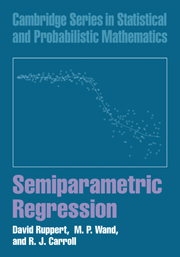Book contents
- Frontmatter
- Contents
- Preface
- Guide to Notation
- 1 Introduction
- 2 Parametric Regression
- 3 Scatterplot Smoothing
- 4 Mixed Models
- 5 Automatic Scatterplot Smoothing
- 6 Inference
- 7 Simple Semiparametric Models
- 8 Additive Models
- 9 Semiparametric Mixed Models
- 10 Generalized Parametric Regression
- 11 Generalized Additive Models
- 12 Interaction Models
- 13 Bivariate Smoothing
- 14 Variance Function Estimation
- 15 Measurement Error
- 16 Bayesian Semiparametric Regression
- 17 Spatially Adaptive Smoothing
- 18 Analyses
- 19 Epilogue
- A Technical Complements
- B Computational Issues
- Bibliography
- Author Index
- Notation Index
- Example Index
- Subject Index
4 - Mixed Models
Published online by Cambridge University Press: 06 July 2010
- Frontmatter
- Contents
- Preface
- Guide to Notation
- 1 Introduction
- 2 Parametric Regression
- 3 Scatterplot Smoothing
- 4 Mixed Models
- 5 Automatic Scatterplot Smoothing
- 6 Inference
- 7 Simple Semiparametric Models
- 8 Additive Models
- 9 Semiparametric Mixed Models
- 10 Generalized Parametric Regression
- 11 Generalized Additive Models
- 12 Interaction Models
- 13 Bivariate Smoothing
- 14 Variance Function Estimation
- 15 Measurement Error
- 16 Bayesian Semiparametric Regression
- 17 Spatially Adaptive Smoothing
- 18 Analyses
- 19 Epilogue
- A Technical Complements
- B Computational Issues
- Bibliography
- Author Index
- Notation Index
- Example Index
- Subject Index
Summary
Introduction
Mixed models are an extension of regression models that allow for the incorporation of random effects. However, they also turn out to be closely related to smoothing. In fact, we will show in Section 4.9 that the penalized spline smoother exactly corresponds to the optimal predictor in a mixed model framework. This link allows for mixed model methodology and software to be used in semiparametric regression analysis, as we will demonstrate in subsequent chapters.
This chapter begins with a brief review of mixed models. Readers with detailed knowledge of mixed models could skip these sections and proceed directly to Section 4.9.
Mixed Models
Much of the early work on mixed models – in particular, the special case of variance component models – was motivated by the analysis of data from animal breeding experiments and driven by the need to incorporate heritabilities and genetic correlations in a parsimonious fashion. They have also played an important role in establishing quality control procedures and determination of sampling designs, among other applications. Overviews of this vast topic are provided by Searle, Casella, and McCulloch (1992), Vonesh and Chinchilli (1997), Pinheiro and Bates (2000), Verbeke and Molenberghs (2000), and McCulloch and Searle (2001).
A more contemporary application of mixed models is the analysis of longitudinal data sets (see e.g. Laird and Ware 1982; Diggle et al. 2002). We will use this setting to illustrate the essence of mixed modeling.
Figure 4.1 shows two representations of data pertaining to weight measurements of 48 pigs for nine successive weeks. Figure 4.1(a) is simply a scatterplot of the weights against their corresponding week number; in Figure 4.1(b), lines are drawn connecting those measurements that belong to the same pig.
- Type
- Chapter
- Information
- Semiparametric Regression , pp. 91 - 111Publisher: Cambridge University PressPrint publication year: 2003

